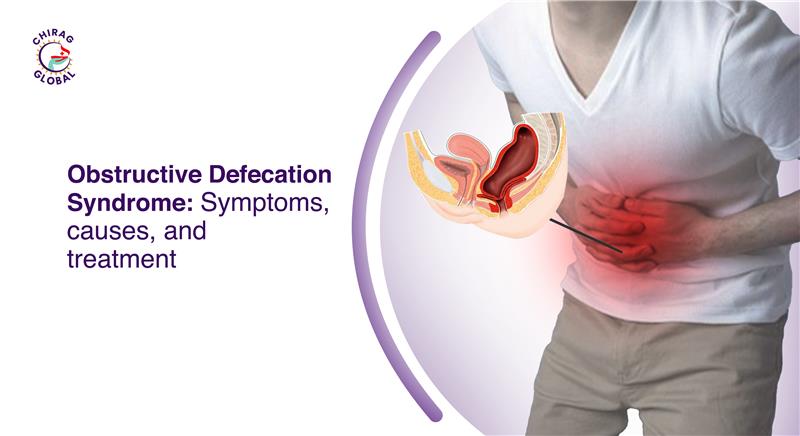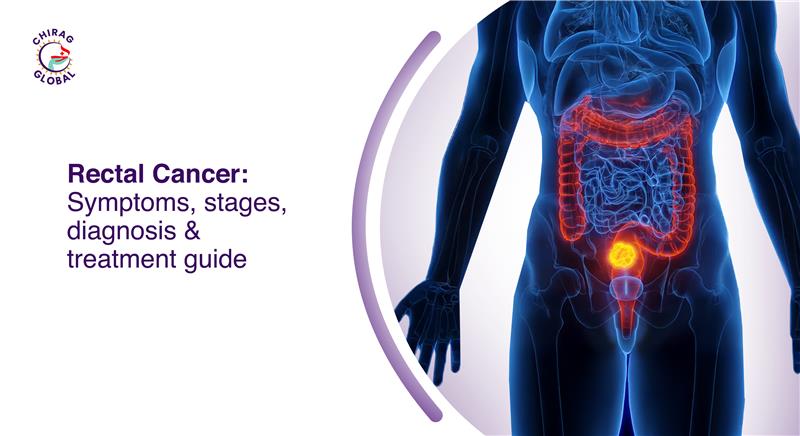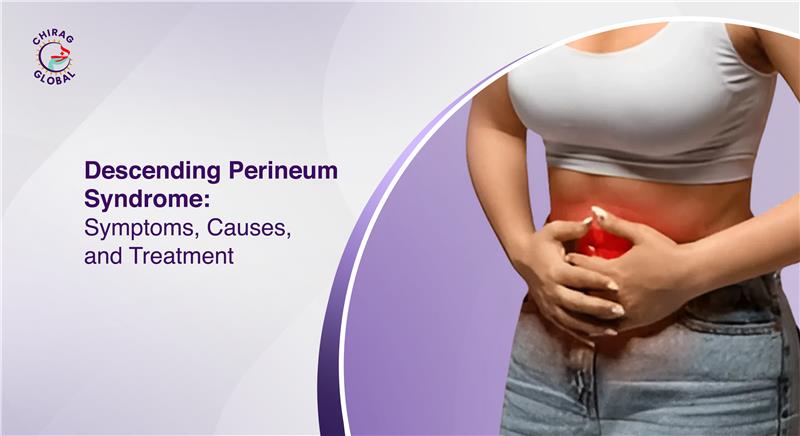By Chirag Global Hospitals

Most people experience constipation once in a while, often due to dietary changes, dehydration, or stress. But when bowel movements become consistently difficult despite eating well and staying hydrated, it may indicate a more complex problem. One such condition is Obstructive Defecation Syndrome (ODS).
ODS is not just “ordinary constipation.” It is a medical disorder where the process of passing stool is mechanically or functionally obstructed. Understanding ODS is crucial, as untreated cases can lead to long-term discomfort, complications, and reduced quality of life.
This article provides a clear, medically accurate, and easy-to-follow explanation of ODS — its symptoms, causes, effects on the body, treatments, and prognosis.
What is Obstructive Defecation Syndrome?
Obstructive Defecation Syndrome (ODS) is a type of functional constipation where the problem lies in stool evacuation rather than stool formation. In simple words, the intestines may be functioning normally, but the body struggles to expel stool because of structural or functional blockages in the rectum or pelvic floor.
ODS is classified under pelvic floor dysfunctions and is more common among women, particularly after childbirth. However, men can also develop the condition.
Unlike occasional constipation, ODS is chronic and often requires medical evaluation and long-term management.
Symptoms of Obstructive Defecation Syndrome
ODS symptoms go beyond simple constipation. Common signs include:
- Straining excessively during bowel movements
- A sensation of incomplete evacuation (feeling like stool is still inside)
- Needing to use fingers (digital assistance) to help remove stool
- Passage of small, hard stools or very thin stools
- Frequent urge to defecate with little output
- Abdominal bloating and discomfort
- Rectal pain or bleeding due to straining
- In severe cases, rectal prolapse (rectum protruding outside the anus)
📌 Key Difference: Ordinary constipation is often temporary, but ODS persists even with dietary changes, hydration, and fiber intake.
👉 If you regularly experience these symptoms, it is important to consult a colorectal specialist rather than self-medicating with laxatives.
What Are Its Causes?
The causes of ODS are usually a combination of structural problems and functional disorders in the rectum and pelvic floor.
1. Structural Causes
- Rectocele: A bulge in the rectal wall into the vagina (common in women after childbirth).
- Rectal Intussusception: The rectum folds in on itself, blocking stool passage.
- Rectal Prolapse: The rectum slips out of its normal position.
- Anal Strictures or Scarring: Narrowing of the anal canal due to previous surgery, trauma, or chronic inflammation.
2. Functional Causes
- Pelvic Floor Dyssynergia: The pelvic floor muscles fail to relax properly during defecation.
- Weak Pelvic Floor Muscles: Often due to childbirth, aging, or surgery.
- Nerve Dysfunction: Damage to nerves controlling bowel function.
3. Lifestyle & Secondary Factors
- Chronic constipation leads to rectal muscle dysfunction.
- Overuse of laxatives which weaken bowel reflexes.
- Pregnancy and childbirth trauma.
- Menopause-related hormonal changes.
ODS is usually diagnosed with specialised tests such as defecography, anorectal manometry, or MRI scans to identify the exact cause.
How Does This Condition Affect the Body?
ODS affects not just bowel movements but also overall health and well-being.
Digestive System Impact
- Frequent straining increases the risk of hemorrhoids and anal fissures.
- Rectal prolapse may develop over time.
- Stool retention can lead to fecal impaction (hardened stool stuck in the rectum).
General Health Impact
- Chronic bloating and abdominal discomfort.
- Increased fatigue due to straining and incomplete evacuation.
- Possible urinary incontinence in women due to pelvic floor weakness.
Psychological Impact
- Anxiety and embarrassment about bowel habits.
- Social withdrawal, avoiding outings due to fear of discomfort.
- Reduced quality of life.
Left untreated, ODS can become severely disabling, making timely medical intervention crucial.
Diagnosis: How It’s Identified
If you experience chronic constipation or pelvic floor symptoms, a doctor, usually a colorectal surgeon, gastroenterologist, or urogynecologist, may evaluate you for DPS.
Common diagnostic methods include:
- Physical examination: Checking perineal descent during straining.
- Defecography (X-ray or MRI): Imaging performed while passing stool to observe pelvic movement.
- Anorectal manometry: Measures muscle function and coordination.
- Endoanal ultrasound: Assesses pelvic muscle structure.
📌 Early diagnosis is key to preventing complications and choosing the right treatment approach.
Defecography
Defecography is a specialised imaging test that records real-time video X-rays of the rectum and anal canal while a patient mimics a bowel movement, often by evacuating a contrast paste or gel introduced into the rectum. This allows clinicians to assess the mechanics and coordination of pelvic floor muscles and determine causes of chronic constipation, fecal incontinence, or obstructed defecation, visualising issues such as rectal prolapse, rectocele, or pelvic floor dysfunction.
Anorectal Manometry
Anorectal manometry is a diagnostic procedure that measures pressures within the rectum and anal canal using a thin tube equipped with pressure sensors. Evaluating muscle strength, coordination, and nerve reflexes helps identify functional disorders such as chronic constipation, fecal incontinence, or Hirschsprung’s disease, and assesses overall rectal and anal sphincter performance.
Endoanal Ultrasound
Endoanal ultrasound involves insertion of a small probe into the anal canal to generate real-time, detailed images of the internal and external anal sphincter muscles. This test is primarily used to detect structural abnormalities, including sphincter injuries or defects, commonly resulting from childbirth, surgery, or trauma, thus guiding treatment for patients with fecal incontinence.
Colonoscopy
It is a medical procedure used to examine the inside of the colon and rectum. During the test, a thin, flexible tube with a small camera at the tip is gently inserted through the rectum, allowing the doctor to view the lining of the large intestine on a screen. It helps detect problems such as inflammation, ulcers, or growths like polyps, which can be removed if necessary during the same procedure. A colonoscopy is often done to check digestive health, investigate symptoms, or as part of routine screening for colorectal conditions.
Treatment Options
Treatment for ODS depends on the underlying cause. A colorectal specialist will usually start with conservative approaches before considering surgery.
1. Lifestyle and Dietary Changes
- High-fiber diet (whole grains, fruits, vegetables).
- Adequate hydration (6–8 glasses of water daily).
- Regular exercise to improve bowel motility.
- Avoiding excessive use of over-the-counter laxatives.
2. Pelvic Floor Physiotherapy
- Biofeedback therapy: Helps retrain pelvic floor muscles to relax properly during defecation.
- Kegel exercises to strengthen weak muscles.
- Relaxation techniques to reduce strain.
3. Medications
- Stool softeners or osmotic laxatives (prescribed by a doctor).
- Suppositories or enemas in selected cases.
- Avoid long-term self-medication, as it can worsen symptoms.
4. Surgical Options
Surgery is recommended when structural abnormalities are the root cause:
- Rectocele Repair: Reinforcement of the rectal wall.
- Stapled Transanal Rectal Resection (STARR): Removal of redundant rectal tissue.
- Rectopexy: To fix rectal prolapse in place.
💡Surgery is only performed after thorough diagnostic testing and when conservative measures fail.
What is Pelvic Floor Disease?
Pelvic floor disease refers to a group of conditions that affect the muscles, ligaments, and connective tissues supporting the pelvic organs (bladder, uterus, vagina, rectum, and anus).
When the pelvic floor is weakened, injured, or does not coordinate properly, it can lead to:
- Urinary problems (incontinence, difficulty starting or stopping urination)
- Bowel issues (constipation, obstructive defecation syndrome, fecal incontinence)
- Pelvic organs prolapse (descent of the bladder, rectum, or uterus into the vaginal canal)
- Sexual dysfunction (pain or discomfort during intercourse)
Pelvic floor disease is especially common in women after childbirth, menopause, or pelvic surgery, but it can also affect men. Treatments may include pelvic floor physiotherapy, medications, biofeedback, or surgery, depending on severity.
What Is the Outlook for People with This Condition?
With proper diagnosis and treatment, the outlook for ODS is generally good.
- Early Intervention: Most patients see significant improvement with biofeedback therapy and dietary changes.
- Surgical Cases: Success rates for STARR and rectocele repair are encouraging, though some patients may still require lifestyle adjustments.
- Long-Term Management: Regular follow-ups with a colorectal specialist help prevent recurrence.
Without treatment, ODS can cause chronic pain, complications, and poor quality of life. With medical care, however, most people regain control and return to normal daily activities.
FAQs about Obstructive Defecation Syndrome
1. Is obstructive defecation syndrome the same as constipation?
No. While both involve difficulty passing stool, constipation is usually due to hard stools or slow bowel movement. ODS is specifically caused by structural or functional problems that prevent stool evacuation.
2. Can ODS be treated without surgery?
Yes. Many patients improve with dietary changes, pelvic floor physiotherapy, and biofeedback therapy. Surgery is only considered if these methods fail.
3. When should I see a doctor for constipation?
See a doctor if:
- Constipation persists for more than 3 weeks.
- You experience severe straining, incomplete evacuation, or rectal bleeding.
- You need manual assistance to pass stool.
4. How do you treat obstructive defecation syndrome?
Obstructed defecation treatment starts with lifestyle changes, including a high-fiber diet and increased water intake, and may include stool softeners or biofeedback therapy. If these fail, surgery such as rectocele repair or stapled transanal resection (STAR) might be necessary. Other therapies include pelvic floor physiotherapy, enemas, or even injections of botulinum toxin for certain causes.
Conclusion
Obstructive Defecation Syndrome is a common but often overlooked cause of chronic constipation. It occurs when structural or functional issues in the rectum and pelvic floor make it difficult to evacuate stool. Chiraayu, an Ayurvedic wing of Chirag Global Hospitals, can be the right solution to Obstructive Defecation Syndrome.
The good news is that ODS is treatable. With early diagnosis, lifestyle changes, physiotherapy, and in some cases surgery, most people can achieve significant relief.
If you or a loved one struggles with chronic constipation, do not ignore the symptoms. Seek advice from a colorectal or proctology specialist for accurate diagnosis and treatment.
Medical Disclaimer: This blog is for educational purposes only and should not replace professional medical consultation. Always consult a qualified healthcare provider for diagnosis and treatment.





